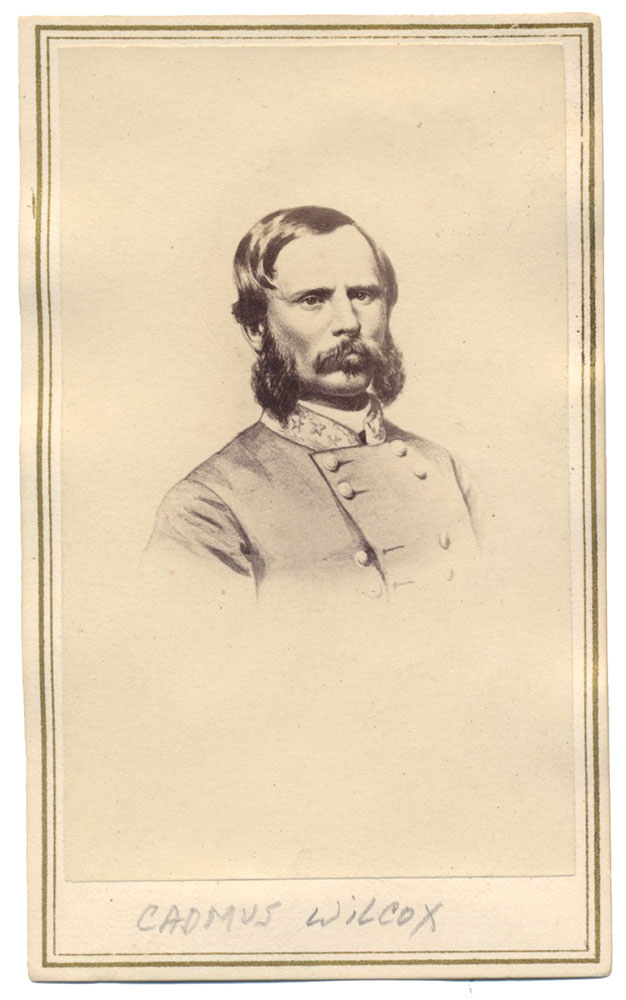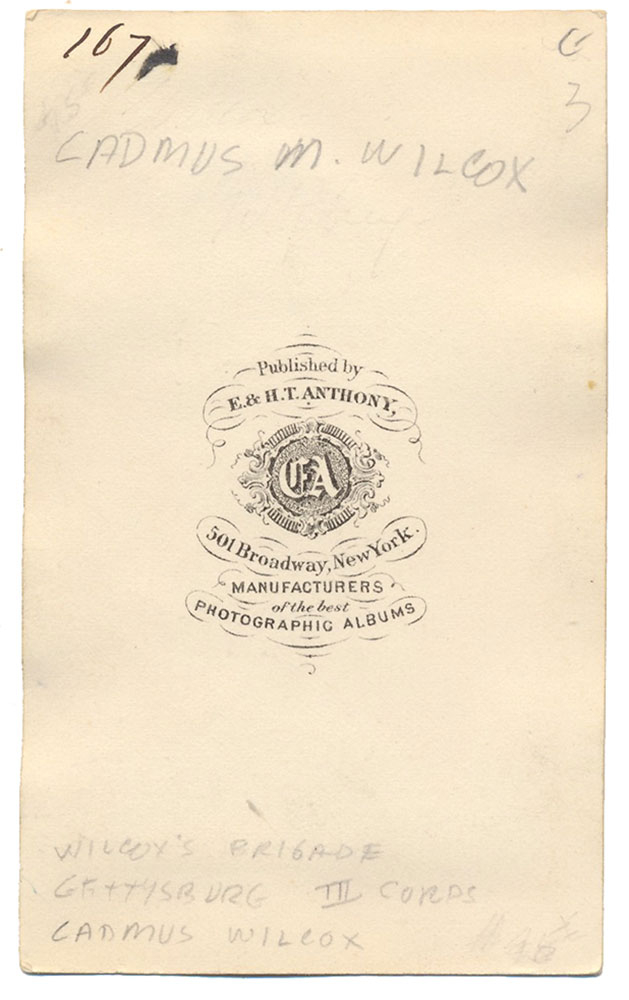site search
online catalog
CDV OF CONFEDERATE GENERAL CADMUS M. WILCOX

Hover to zoom


$300.00 SOLD
Quantity Available: None
Item Code: 1139-216
Carte de visite photograph of a portrait of Wilcox in uniform. Chest up view wearing double-breasted frock with collar insignia. Image is clear with very good contrast. Pencil identifications on front and back. Photographer's backmark, E. & H.T. Anthony, New York.
Cadmus Marcellus Wilcox (May 20, 1824 – December 2, 1890) was a career United States Army officer who served in the Mexican–American War and also was a Confederate general during the Civil War.
Wilcox was born on May 20, 1824, in Wayne County, North Carolina. His family soon relocated to Tipton County, Tennessee, near Memphis, when Wilcox was only two years old. After studying at Cumberland College, he attended West Point, graduating near the bottom of the vaunted class of 1846, which included future notable Civil War generals George B. McClellan and Thomas J. “Stonewall” Jackson.
Wilcox was then sent to serve in the Mexican-American War. He served under both Generals Zachary Taylor and Winfield Scott and earned particular distinction for his part in the Battles of Chapultepec and Mexico City. For his gallant actions, he was promoted to brevet first lieutenant. After Mexico, Wilcox served in various frontier posts. He then became assistant instructor of infantry tactics at West Point from 1852-57, when failing health forced him to take a year-long leave to travel through Europe. He then wrote Rifles and Rifle Practice, which was the first American textbook to discuss the mechanics of the rifled musket and would become the Army’s standard textbook on the topic.
When Tennessee seceded in June 1861, Wilcox resigned his commission in the US Army. He then became colonel of the 9th Alabama Infantry Regiment, which fought at First Bull Run. He was promoted to brigadier general on October 21, 1861, to serve under General James Longstreet. He and his brigade played a crucial rule in the 1862 Battle of Williamsburg. At the Seven Days Battles, he proved himself to be an able commander, despite losing nearly every regimental officer in his brigade and a casualty rate higher than any other brigade in Longstreet’s division.
His brigade was held in reserve at Second Bull Run, and he was ill and thus out of action during the 1862 Antietam Campaign. During the 1863 Battle of Chancellorsville, Wilcox’s brigade was assigned to guard Banks’ Ford on the Rappahannock River, away from the main fighting. On May 3, he marched his brigade to the sounds of guns at Fredericksburg. Arriving too late to participate in the Second Battle of Fredericksburg, Wilcox nonetheless deployed his brigade and a scant force of cavalry and artillery in the path of a Federal force marching toward the Confederate rear at Chancellorsville. In a masterful delaying action, Wilcox’s undersized force delayed the Federals for hours, and then stopped them cold at Salem Church after receiving reinforcements from Lee.
Passed over for promotion as Lee reorganized his army in the wake of the Battle of Chancellorsville, “Uncle Billy Fixin,” as he was known to his men, next served as the Battle of Gettysburg. On the second day of the battle, skirmishing along the Emmitsburg Road culminated with division commander Richard H. Anderson ordering an attack against a weakened Union center. Wilcox’s Alabamians supported by an undersized Florida brigade assaulted the Union center. Unaware of their ultimate objective, and lacking leadership from Anderson, Wilcox’s attack foundered, and an outnumbered Minnesota regiment was able to repulse the attack. On the next day, Wilcox’s brigade was assigned to support the right flank of Lee’s frontal assault on Cemetery Ridge known as Pickett’s Charge. Although not subject to small arms fire, his brigade was exposed to “close and terrible fire of artillery” from the guns massed on Cemetery Ridge. Wilcox lost more than 200 men during the third day.
In late 1863, he was promoted to major general and at the head of a division, serving General A.P. Hill in the Confederate Third Corps. His new division experienced heavy fighting at the Wilderness, Spotsylvania, and Petersburg. At Petersburg, Wilcox’s desperate stand at Forts Gregg and Alexander on April 2, 1865, helped to cover the battered Army of Northern Virginia’s retreat to the west. When General Lee surrendered to General Ulysses S. Grant on April 9, 1865, at Appomattox Court House, Wilcox was preparing to break through Union lines.
After the war, he resided in Washington, DC, and remained a bachelor for the rest of his life. He was offered a command in the Egyptian Army but turned it down to take care of his eldest brother’s widow and children. In 1886, President Grover Cleveland appointed him to the post of chief of the railroad division of the US Government Land Office, a post in which he served for the rest of his life.
Wilcox died at the age of sixty-six in Washington, D.C., and was buried there in Oak Hill Cemetery. [jet] [ph:L]
~~~~~~~~~~~~~~~~~~~~~~~~~~~~~~~~~~~
THIS ITEM, AS WITH ALL OTHER ITEMS AVAILABLE ON OUR WEB SITE,
MAY BE PURCHASED THROUGH OUR LAYAWAY PROGRAM.
CLICK HERE FOR OUR POLICIES AND TERMS.
THANK YOU!
Inquire About CDV OF CONFEDERATE GENERAL CADMUS M. WILCOX
Most Popular
Historical Firearms Stolen From The National Civil War Museum In Harrisburg, Pa »
Theft From Gravesite Of Gen. John Reynolds »
Selection Of Unframed Prints By Don Troiani »
Fine Condition Brass Infantry Bugle Insignia »
Large English Bowie Knife With Sheath 1870’S – 1880’S »
Imported (Clauberg) Us Model 1860 Light Cavalry Officer's Saber »
featured item
CLOSE TO REGULATION VIRGINIA CONFEDERATE CAPTAIN'S FROCK COAT
The coat is made of mid- gray wool, possibly imported from England. It has full-length skirts ending in the typical and desirable raw edge. The sleeves have an 8 1/2-inch billow at the elbow. The dark blue wool standing collar is 1-1/2 inches high… (1268-060). Learn More »


